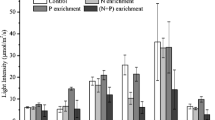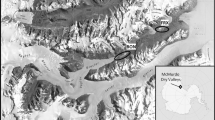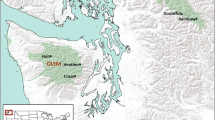Abstract
Seasonal nutrient enrichment experiments (short-term bioassays) were conducted in three Florida lakes of different trophic states to determine the effects of addition of various nutrient combinations upon chlorophyll a and phytoplankton standing crops. Nutrient enriched surface water samples with crustacean zooplankton removed were incubated in situ in clear polyethylene bags for 3 to 6 days. The 25 factorial design employed two levels (ambient and enriched) of each of five nutrients [NH4 +, PO sup3−inf4 , Fe− -EDTA, SiO sup2−inf3 and a cation (Ca2+ or K+) or trace elements]. Ammonium produced significant increases in chlorophyll a and phytoplankton standing crops in all experiments. Phosphate produced similar results in the mesotrophic lake, but the eutrophic lakes had both positive and nonsignificant responses which varied seasonally between lakes. Iron increased chlorophyll a in most experiments but affected total phytoplankton standing crop only during the summer and fall. Silicon had negative effects in some experiments. Cations and trace elements produced marked differences between lakes for chlorophyll a, but total phytoplankton standing crop showed few significant responses. Synergistic responses to two- and three-factor interactions were observed in all lakes. Differences in the responses of phytoplankton taxonomic divisions to enrichment may be responsible for much of the between lake variation in chlorophyll a and total phytoplankton volume responses. Nutrient limitations in these lakes are discussed and related to limnological factors and predictive models.
Similar content being viewed by others
References
A.P.H.A., 1975. Standard Methods for the Examination of Water and Wastewater. 14th ed. American Public Health Association, American Water Works Association, and Water Pollution Control Federation, Washington, D.C. 1193 pp.
Anderson, V. L. & R. A. McLean, 1974. Design of Experiments, A Realistic Approach. Marcel Dekker, N.Y. 418 pp.
Baker, L. A., P. L. Brezonik & C. R. Kratzer, 1981. Nutrient loading-trophic state relationships in Florida lakes. Publ. 56, Fla. Wat. Resour. Res. Center, Gainesville. 126 pp.
Canfield, D. E., Jr. & R. W. Bachmann, 1981. Prediction of total phosphorus concentrations, chlorophyll a and secchi depths in natural and artificial lakes. Can. J. Fish. aquat. Sci. 38: 414–423.
Carlson, R. E., 1977. Atrophic state index for lakes. Limnol. Oceanogr. 22: 361–369.
Cowell, B. C., 1960. A quantitative study of the winter plankton of Urschel's Quarry. Ohio J. Sci. 60: 183–191.
Cowell, B. C. & C. J. Dawes, 1984. Algae studies of eutrophic Florida lakes: the influence of aeration on the limnology of a central Florida lake and its potential as a lake restoration technique. Final Report, Fla. Dept. Nat. Resour., Tallahassee, 299 pp.
Cowell, B. C., C. J. Dawes, W. E. Gardiner & S. M. Scheda, 1987. The influence of whole lake aeration on the limnology of a hypereutrophic lake in central Florida. Hydrobiologia 148: 3–24.
Dawes, C. J. & B. C. Cowell, 1984. Algal studies of eutrophic Florida lakes: Determination of factors responsible for nuisance blooms of planktonic algae in central Florida. Final Report. Fla. Dept. Nat. Resour., Tallahassee. 133 pp.
Dawes, C. J., B. C. Cowell, W. E. Gardiner & S. M. Scheda, 1987. Limnological characteristics of two eutrophic and four mesotrophic lakes in west-central Florida. Int. Revue ges. Hydrobiol. 72: 171–203.
Dillon, P. J. & F. H. Rigler, 1974. The phosphorus-chlorophyll relationship in lakes. Limnol. Oceanogr. 19: 767–773.
Dillon, P. J. & F. H. Rigler, 1975. A simple method for predicting the capacity of a lake for development based on lake trophic status. J. Fish. Res. Bd Can. 32: 1519–1531.
Dunst, R. C., S. M. Born, P. D. Uttormark, S. A. Smith, S. A. Nichols, J. O. Peterson, D. R. Knauer, S. L. Kerns, D. R. Winter & T. L. Wirth, 1974. Survey of lake rehabilitation techniques and experiences. Tech. Bull. 75, Wisc. Dept. Nat. Resour., Madison. 179 pp.
Edmondson, W. T., 1959. Methods and equipment. In W. T. Edmondson (ed.), Freshwater Biology. John Wiley and Sons, N.Y.: 1194–1202.
Holm-Hansen, O. & B. Riemann, 1978. Chlorophyll a determination: improvements in methodology. Oikos 30: 438–447.
Hudson, P. L. & B. C. Cowell, 1966. Distribution and abundance of phytoplankton and rotifers in a main-stem Missouri River reservoir. Proc. S. D. Acad. Sci. 45: 84–106.
Jones, J. R. & R. W. Bachmann, 1976. Prediction of phosphorus and chlorophyll levels in lakes. J. Wat. Pollut. Cont. Fed. 48: 2176–2182.
Kalff, J. & R. Knoechel, 1978. Phytoplankton and their dynamics in oligotrophic and eutrophic lakes. Ann. Rev. Ecol. Syst. 9: 475–495.
Lehman, J. T., D. B. Botkin & G. E. Likens, 1975. The assumptions and rationales of a computer model of phytoplankton dynamics. Limnol. Oceanogr. 20: 343–364.
Lorenzen, C. J., 1967. Determination of chlorophyll and phaeopigments: spectrophotometric equations. Limnol. Oceanogr. 12: 343–346.
Nichols, H. W. & H. C. Bold, 1965. Trichosarcina polymorpha Gen. et Sp. Nov. J. Phycol. 1: 34–38.
N.O.A.A., 1983. Climatological data for Florida. Natl. Atmos. Adm., Natl Climat. Center, Ashville, N.C., Vol. 87.
Paine, R. T., 1980. Food webs: Linkage, interaction strength and community infrastructure. J. anim. Ecol. 49: 667–685.
Robarts, R. D., 1987. Effect of rainstorms on heterotrophic bacterial activity in a hypereutrophic African lake. Hydrobiologia 148: 281–286.
Scheda, S. M. & B. C. Cowell, 1988. Rotifer grazers and phytoplankton: seasonal experiments on natural communities. Arch. Hydrobiol. 114: 31–44.
Sakamoto, M., 1966. Primary production by phytoplankton community in some Japanese lakes and its dependence on lake depth. Arch. Hydrobiol. 62: 1–28.
SAS, 1985. SAS User's Guide: Statistics, Version 5 Edition. SAS Institute Inc., Cary, N.C., 956 pp.
Setaro, F. V. & J. M. Melack, 1984. Responses of phytoplankton to experimental nutrient enrichment in an Amazon floodplain lake. Limnol. Oceanogr. 29: 972–984.
Schindler, D. W., 1978. Factors regulating phytoplankton production and standing crop in the world's freshwaters. Limnol. Oceanogr. 23: 478–486.
Smith, V. H., 1982. The nitrogen and phosphorus dependence of algal biomass in lakes: An empirical and theoretical analysis. Limnol. Oceanogr. 27: 1101–1112.
Smith, V. H. & J. Shapiro, 1981. Chlorophyll-Phosphorus relations in individual lakes. Their importance to lake restoration strategies. Envir. Sci. Technol. 15: 444–451.
Stenson, J. A. E., 1982. Fish impact on rotifer community structure. Hydrobiologia 87: 57–64.
U.S. EPA, 1979. Methods for chemical analysis of water and wastes. EPA 600/4–79–020. U.S. Envir. Prot. Ag., Cincinnati. 116 pp.
U.S. EPA, 1982. Handbook for sampling and sample preservation of water and wastewater. EPA 600/4–82–029. U.S. Envir. Prot. Ag., Cincinnati. 402 pp.
Verduin, J., 1960. Phytoplankton communities of western Lake Erie and the CO2 and O2 changes associated with them. Limnol. Oceanogr. 5: 372–380.
Vollenweider, R. A., 1975. Input-output models with special reference to the phosphorus loading concept in limnology. Schweiz. Z. Hydrol. 37: 53–84.
Vollenweider, R. A., 1976. Advances in defining critical loading levels for phosphorus in lake eutrophication. Mem. 1st ital. Idrobiol. 33: 53–83.
Wurtsbaugh, W. A., W. F. Vincent, R. Alfaro Tapia, C. L. Vincent & P. J. Richerson, 1985. Nutrient limitation of algal growth and nitrogen fixation in a tropical alpine lake, Lake Titicaca (Peru/Bolivia). Freshw. Biol. 15: 185–195.
Zaret, T. M., A. H. Devol & A. Dos Santos, 1981. Nutrient addition experiments in Lago Jacaretinga, central Amazon Basin, Brazil. Verh. int. Ver. Limnol. 21: 721–724.
Author information
Authors and Affiliations
Rights and permissions
About this article
Cite this article
Cowell, B.C., Dawes, C.J. Nutrient enrichment experiments in three central Florida lakes of different trophic states. Hydrobiologia 220, 217–231 (1991). https://doi.org/10.1007/BF00006578
Received:
Revised:
Accepted:
Issue Date:
DOI: https://doi.org/10.1007/BF00006578




